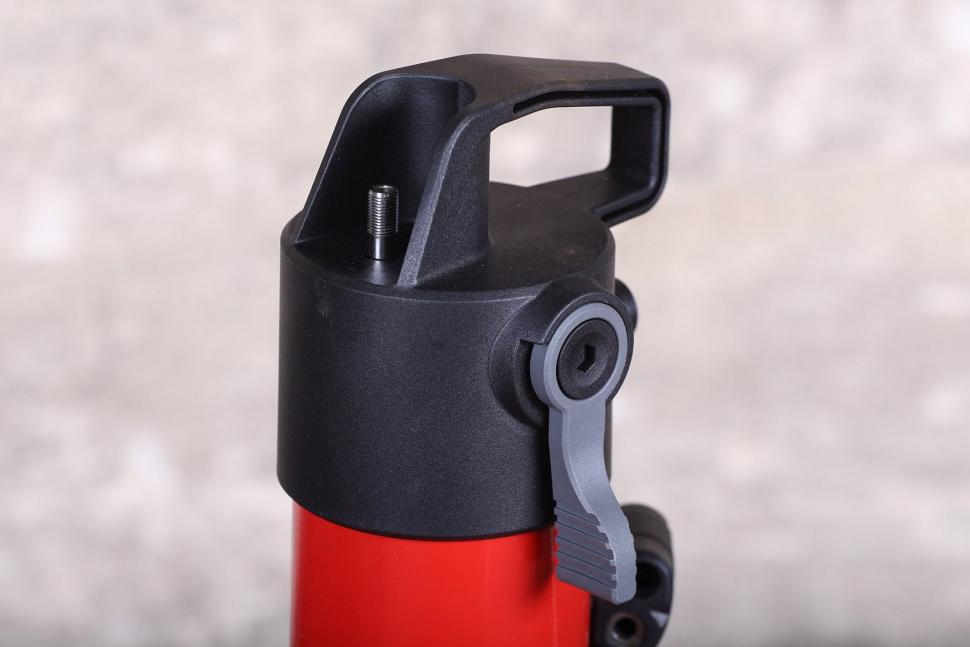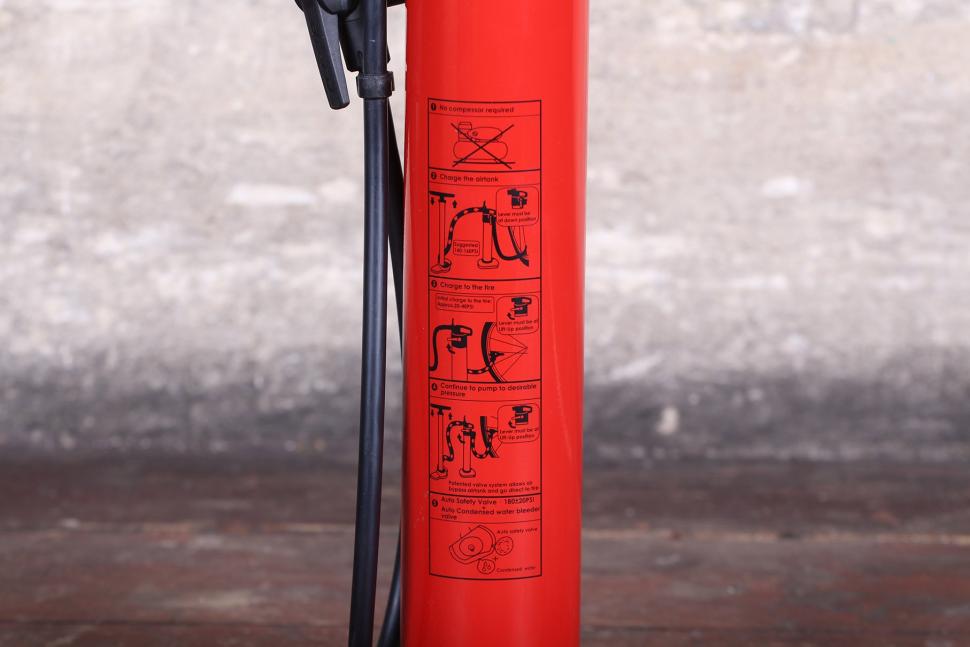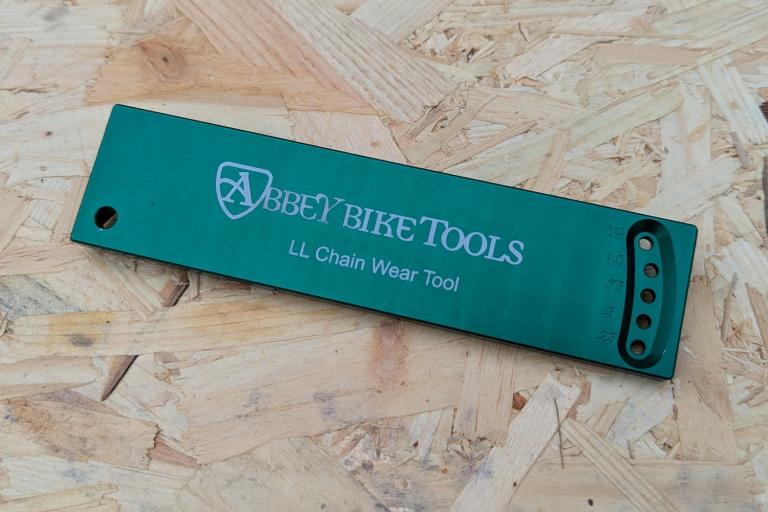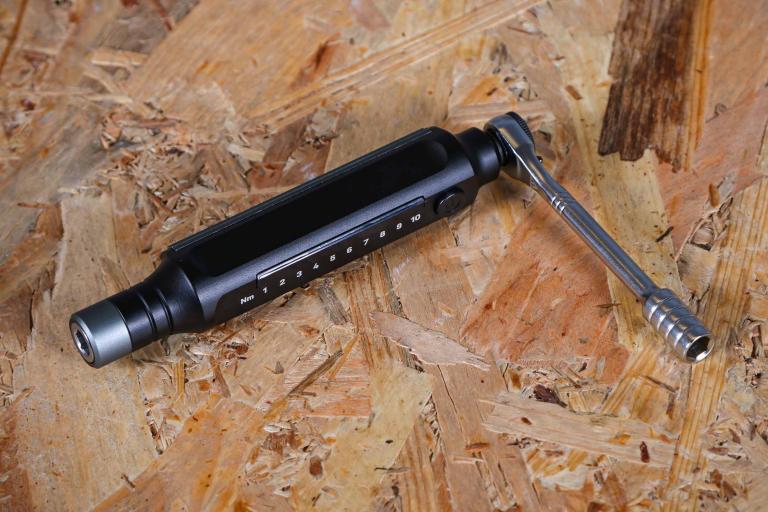- News
- Reviews
- Bikes
- Components
- Bar tape & grips
- Bottom brackets
- Brake & gear cables
- Brake & STI levers
- Brake pads & spares
- Brakes
- Cassettes & freewheels
- Chains
- Chainsets & chainrings
- Derailleurs - front
- Derailleurs - rear
- Forks
- Gear levers & shifters
- Groupsets
- Handlebars & extensions
- Headsets
- Hubs
- Inner tubes
- Pedals
- Quick releases & skewers
- Saddles
- Seatposts
- Stems
- Wheels
- Tyres
- Tubeless valves
- Accessories
- Accessories - misc
- Computer mounts
- Bags
- Bar ends
- Bike bags & cases
- Bottle cages
- Bottles
- Cameras
- Car racks
- Child seats
- Computers
- Glasses
- GPS units
- Helmets
- Lights - front
- Lights - rear
- Lights - sets
- Locks
- Mirrors
- Mudguards
- Racks
- Pumps & CO2 inflators
- Puncture kits
- Reflectives
- Smart watches
- Stands and racks
- Trailers
- Clothing
- Health, fitness and nutrition
- Tools and workshop
- Miscellaneous
- Buyers Guides
- Features
- Forum
- Recommends
- Podcast
£49.99
VERDICT:
Top-quality workshop-grade tubeless inflator at a sensible price
Weight:
1,980g
Contact:
At road.cc every product is thoroughly tested for as long as it takes to get a proper insight into how well it works. Our reviewers are experienced cyclists that we trust to be objective. While we strive to ensure that opinions expressed are backed up by facts, reviews are by their nature an informed opinion, not a definitive verdict. We don't intentionally try to break anything (except locks) but we do try to look for weak points in any design. The overall score is not just an average of the other scores: it reflects both a product's function and value – with value determined by how a product compares with items of similar spec, quality, and price.
What the road.cc scores meanGood scores are more common than bad, because fortunately good products are more common than bad.
- Exceptional
- Excellent
- Very Good
- Good
- Quite good
- Average
- Not so good
- Poor
- Bad
- Appalling
The Beto CJA-001S Tubeless Air Tank Inflator is a workshop-quality tubeless air tank with well-thought-out features and excellent performance. It should last you a lifetime of tubeless setup, road or mountain.
Last year David reviewed the Airshot tubeless inflator and found it effective but costly at £60 (now £50). The key difference between the Airshot and the Beto tank on review here is size and weight. The Airshot will fit easily into a gearbag, whereas the Beto tank is much more of a workshop tool. At over four times the weight of the Airshot and considerably larger, you wouldn't want to be packing the Beto tank about the place.
That workshop-grade feeling helps make the Beto an attractive option for regular tubeless users. It stands on a wide stable foot, with a plastic carrying handle for easy relocation within the workshop or to a place where a sealant explosion is less of a problem. The Schrader refill valve is positioned on top and is protected by a plastic cowling, so if it gets knocked over the valve isn't going to be damaged. This is in comparison to the vulnerable Presta valve sticking out the top of the Airshot.
Buy Beto CJA-001S Tubeless Air Tank Inflator
Find a Beto dealer
The quality feeling of the Beto tank extends to the 70cm hose and fittings. The hose pivots at the tank, feeling solid and tightly-machined. The head likewise feels a quality bit of kit, with no adapter or switching required to inflate either Presta/Woods or Schrader. The insert that grips Presta valve cores is rubber-lined metal; again, no corners cut here. There's a plastic clip to hold the hose end when not in use, looping around a clip at the base to keep the hose secure.
The business end of the Beto Tank is the large grey air release lever on the side – not a small, fiddly tap as on the Airshot. This is good because you'll probably find yourself with only one hand free during a tubeless mounting session, so a tank that sits stable on the floor and can be operated with one hand is A Good Thing. The lever is able to release air gradually, not a binary open-closed action. The tank took about 40 strokes of my long-lived Bontrager Charger floorpump to get to 120PSI. Beto recommend 120-140PSI, and there's a safety cutout valve on the bottom at 180PSI, which incorporates a moisture release function too, though Beto make no mention of how often or how this should be actuated.
A feature of the Beto tank is an air bypass function, which allows you to continue inflating a tyre using your trackpump still connected to the tank. I never found this to be necessary, as all the tyres I tried seated fine the first time, but it's nice to know it's possible.
With 120PSI in the tank I was able to seat a 30mm tubeless road tyre, the first shot with no sealant to get the tyre tight on the rim at 70PSI without excess mess. Then I released all the air, inserted sealant using the rather fab Milkit system and refilled again with a valve core in place this time, managing a perfectly respectable 40PSI the second time around. So, seat, deflate, fill with sealant and reinflate tyre, all with one charge.
With 120PSI in the tank I was able to seat and fill a 2.3in mountain bike tyre to 18PSI with no problems at all. The capacity was more than enough to get both beads seated, and using the pass-through feature, if you wanted or needed to get the tyre a bit harder you could do so without disturbing the connection to the valve.
As tubeless becomes a feature of many road as well as mountain bikes, the need to seat and inflate tyres without resorting to a bike shop trip will become more and more common. For the price of an average track pump the Beto Tubeless Air Tank gives you the ability to DIY with workshop-grade speed and quality.
Verdict
Top-quality workshop-grade tubeless inflator at a sensible price
road.cc test report
Make and model: Beto CJA-001S Tubeless Air Tank Inflator
Size tested: Works with most 160-PSI rated floor pumps
Tell us what the product is for, and who it's aimed at. What do the manufacturers say about it? How does that compare to your own feelings about it?
It's for people running road or MTB tubeless, who want no-fuss, workshop-grade features at a good price.
Tell us some more about the technical aspects of the product?
Jet Air 1601-PSI Air Accumulator
Works with most 160-PSI rated floor pumps
Provides continuous large air flow to pop-seal tubeless tyre's
4-second inflation for most tubeless tyres with 160PSI charged in the tank
Patented bypass air channel allows for air to go flow directly
Charge: Schrader valve / Discharge: Beto patented 3-valve LD head
Heavy gauge steel structure tested up to 700PSI
Rate the product for quality of construction:
10/10
It's bomb-proof.
Rate the product for performance:
9/10
Seated tyres first time, every time.
Rate the product for durability:
9/10
Rate the product for weight (if applicable)
7/10
It is what it is - a shop tool, therefore it's not light.
Rate the product for value:
10/10
For £50 (£40-£50 online) this has to be the best value out there.
Tell us how the product performed overall when used for its designed purpose
Can't fault it.
Tell us what you particularly liked about the product
The build quality. Everything was solid and smooth. A good investment.
Tell us what you particularly disliked about the product
Nothing, really. I cannot think of a single thing that annoyed me, even slightly. OK, maybe the hose could be longer. Maybe.
Did you enjoy using the product? Yes
Would you consider buying the product? Yes
Would you recommend the product to a friend? Yes
Use this box to explain your score
At £50, with the features and build quality on show, it's cracking value. Might the hose be a bit longer? Maybe.
About the tester
Age: 43
I usually ride: Merida Ride 5000 Disc My best bike is:
I've been riding for: Over 20 years I ride: A few times a week I would class myself as: Expert
I regularly do the following types of riding: cyclo-cross, club rides, general fitness riding, mtb, Dutch bike pootling
Living in the Highlands, Mike is constantly finding innovative and usually cold/wet ways to accelerate the degradation of cycling kit. At his happiest in a warm workshop holding an anodised tool of high repute, Mike's been taking bikes apart and (mostly) putting them back together for forty years. With a day job in global IT (he's not completely sure what that means either) and having run a boutique cycle service business on the side for a decade, bikes are his escape into the practical and life-changing for his customers.
Latest Comments
- mark1a 2 sec ago
No. Within a very short period of time, the RRP on these items will have ratcheted up to where they were before, with the exchequer not getting VAT...
- velodinho 25 min 9 sec ago
As witnessed at so many infrastructure improvement projects similar to this one, all those who object should ignore the consultation and pray at...
- Nagai74 2 hours 13 min ago
It's a DLO to those in the trade.
- chrisonabike 2 hours 28 min ago
Surely as a former bridleway these should be equid-based e.g. "hoof-depth" / "up to the fetlock" / "approaching hock/knee"?...
- Tom_77 2 hours 52 min ago
Cars keep getting wider and wider, but it's those damn cyclists with their wide handlebars that are the real problem. ref
- bikes 3 hours 49 min ago
"it's almost entirely from recycled composite materials". What percentage of the carbon frame is made from recycled carbon?
- David9694 7 hours 48 min ago
Motorist Mike demands 40p back after overcharged on new £11m 'prison' car park...
- PRSboy 20 hours 53 min ago
I have two aero bikes- an Argon18 Nitrogen and an Orro Venturi. I love the way they feel on the road. I also like the style of the deeper section...
- Rendel Harris 1 day 4 hours ago
They have here: results at 14.40. The aero bike was roughly fifteen seconds faster than a climbing bike on a descent of around 6 km, so about 3km/h...
- wtjs 1 day 4 hours ago
As I've also placed here the nutter Audi and white van drivers, I've decided to give those no-nonsense keep-the-country-moving BMW drivers a list...













Add new comment
23 comments
It might be six years later but I've just bought this. Happy to say it's still a relevant purchase for road/gravel tubeless. I was having huge difficulty getting a set of 35mm Gravelkings seated with nothing else working - Airshot defeated, in-pump booster defeated. This tank did one tyre first time and the second needed an additional fill, that's how tight it was. On that basis I'm pretty confident this will handle anything, even a GP5000 TL. Well worth the £45 I paid for it. Time is money.
Just ordered this after a few recent tricky inflations on tubeless set ups. Interesting to read some of the comments...
To weigh in with my tuppence worth. I've been using tubeless on my gravel bike (2 sets of wheels, one gravel, the other with road tyres) for 18 months and on my MTB for 6 months. People who are puncturing badly enough to feel they have to use innertubes are doing it wrong.
I've punctured so badly as to not let sealant repair on several occassions, but that's when you pull out tyre noodles. I have NEVER had to resort to a) removing a wheel, b) removing a tyre and c) putting in an innertube. I simply repair with a tyre noodle and away I go.
The cost of tyres is now on a par with a decent set of road tyres (recently picked up some Panaracers Superkings for £20 each, and a pair of Michelin MTB tyres for £10 each, both Tubeless Compatible). Many wheel manufacturers are dropping costs too.
What ever initial outlay (valves, tape and sealant) I've had to invest in has been fully recouped by the saving in innertubes not purchased!
Will people please stop quoting entire chunks of thread? I've read the whole thing already thanks.
Just because it's quoted, doesn't mean that you have to read it again...
"Yeah, I mean, what did road tubeless ever do for us?"
The Peoples of Front of Tubea.
splitters!
I'm quietly surprised at the way some cyclists accept the need for this expensive gadget, which is required solely as a technical fix for the shortcomings of current tubeless technology. The manufacturers are taking the piss, don't buy it and don't buy tubeless tyres until they make the things work properly.
Obvious troll is obvious.
Unless you're serious, in which case forget the previous , I'll bite:
, I'll bite:
Many tubeless tyre/rim combos will now pop in place using a standard trackpump (avg price £30for a good one). For those that don't, or for really fat ones where the inrush volume needed to seat the beads is a lot, there's tools like the Beto.
An air tank is a relatively inexpensive, use-first-time tool that enables you to easily and confidently run tubeless tyres on or off-road, thereby saving money over time in inner tubes, patch kits and many, many stops by the roadside in oft-poor winter weather to repair/replace inner tubes.
...I'm assuming you are waiting for inner tubes that don't go flat due to thorns, because you'd have to use tyre levers, and that's a "technical fix for the shortcomings of current [inner tube] technology". Don't buy into the Inner-Tube Industrial Complex consumer rip-off. They WANT you to keep using inner tubes. And keep replacing snapped tyre levers. And patch kits...fight the power etc etc
How many punctures are you getting? even with CX tyres which tend to puncture soon as look at anything pointy. I only get a few a years 4/5 more than I used to granted with road tyres which averaged 2, but still not a huge amount and i use the CX more like a lite MTB.
kit for tubless is higher end be that tyres, wheelsets and bits that go along with it. plus on going maintence such as replacing sealent possibly cleaning valves.
At the moment inner tubes are a cheaper and simpler solution unless your using a very favourable comparison.
Overwhelming majority of people who tried tubeless wouldn't go back to tubes.
Overwhelming majority of people who oppose tubeless have never tried it and keep talking same nonsense as if they were on some kind of mission.
Fact.
I'm sure lots of people are very happy with tubless but they seem to be mostly in forums, the riders out in the road/trails are still using tubes, now some may not realise they could but equally others like myself it's simply just not worth the hassle/cost at this point in time.
One of the MTB YouTube did a poll few months back, and even for the sort of MTB that has a good bike etc, vast majority are on tubes.
You're kidding, right? So people who are "very happy with tubless [sic]" are not real people, they only exist "in forums"? This whole thing is a marketing ploy by the Tubeless Industrial Complex to con people like you?
I've written numerous reviews of tubeless products - tyres, wheels, inflators, repair kits - and i've always been 100% open and honest about any issues I find. When I tell you that I've gone from repairing maybe half a dozen inner tubes a month to repairing nothing and just riding, ***I am not lying***.
I live in a very rural part of the South, on chalk downland where every field contains a few thousand tons of flint, and every season a bajillion tiny flint shards are born during the ploughing process. These are washed or carried into the road by farm vehicles or rain. It used to be a strangely satisfying daily ritual, picking shards of flint out of very good tyres such as Conti GP 4Seasons, Gatorskin Hardshells etc. I used to have a *jar* of removed flints - some up to 5mm long. It is testament to Continental's puncture resistance that I only used to flat maybe half a dozen times a month.
When I set up tubeless tyres these days, they go up first time, and stay up. Mostly any cut will seal instantly with no intervention from me. Last time I recall even hearing a hiss was about 6 months ago, and that stopped within seconds. Maybe once a year there will be a 3mm+ cut that requires a rubber plug to seal - done on the roadside, no mess, no faff, not even removing the wheel.
To summarise: buying modern tubeless-ready rims and tubeless tyres, there is no 'hassle'. Lever off one part of the bead, add 30ml of sealant, inflate, ride. How hard is that? Check sealant level every 4-6 months, add more as needed. 1 minute job. If you're buying the bike new, get the shop to set the sealant/valve up before delivery (all tubeless bikes ship with an inner tube. some wheels might need taping as the provided rim tape isn't airtight, some come with airtight rims that don't need tape).
You are living under a false conception that road tubeless is both 'hassle' and 'cost'. The truth is that these days it's neither. You save a lot of time, particularly in crap cold weather, and in the long term you save money in inner tubes and patch kits. Even more if you actually put a value on your time spent repairing flats, roadside or at home. And if you want/need to, putting a tube back in is as easy as putting a tube in.
A tool like this Beto tank is a once-in-a-lifetime purchase that makes maintaing tubeless easier. It's not essential, depending on your mix of rim/tyre.
No-one's making you use tubeless. But please, don't make claims that might put others off. You haven't tried it so don't know the reality.
so all the folks you meet use tubless? No? That my point. I get that folks into the kit or the advantages for them make more sense.
cost really isn't arguable, ( 6 punctures a month chalk flints or not isn't normal frankly a outliner) tubeless tyres are still high end i.e. Costly and most normal folks would possibly have that many in a year, plenty lot less, and inner tubes are hardly expensive.
most folks will need tubeless kit, and plenty would need new wheels.
Roger, you said people who use tubeless only exist on Internet forums, and everyone out on the road users tubes. This is patent nonsense.
You have not used Road tubeless, I'm guessing, so you cannot offer an opinion on the subject you know nothing about.
Cost is a very real factor, both in terms of inner tubes needing replacing/repairing, and also my time spent bent over in the wind and rain on the roadside repairing something when I would much rather be riding.
I've never tried road tubeless, but used on mtb's quite a lot. I've had very good experiences and very bad. Right now I'm back with tubes, but I've just bought some new tyres and am thinking about giving tubeless another go.
Across my mtb mates I'd say that I'm fairly typical, people dip in and out depending on circuimstances and recent experiences.
Tubeless - If they seat quickly it's a wonderful thing. The first time you hear a puncture and the resulting seal is a moment of euphoria.
The first time you have a puncture that won't seal and have to resort to fitting a tube is very messy. The first time it's a split in the tyre and you need a boot to stop the tube coming out of the tyre is a huge pain in the arse because of the gunky inside of the tyre that nothing will ever stick to again.
Looks suspiciously similar to this:
http://www.pro-bikegear.com/global/ms/accessories/pumps/PRO_PU_COMPRESSOR
(rebadge?)
The head's different, but otherwise identical. I highly suspect Pro (owned by Shimano) have rebadged the Beto product.
Or make your own!
http://www.bikeradar.com/mtb/gear/article/how-to-make-a-tubeless-inflato...
or go for the real deal but price at £130but way quieter than my Stanley compressor
https://www.amazon.co.uk/Topeak-JoeBlow-Booster-Tubeless-Schrader/dp/B06...
I spent another £13 for an Airwave Airblast track pump with integrated cylinder which is a neater solution IMHO. Having never used tubeless before I was pleased that my first two attempts (WTB Cyclo-cross tyres and rims) both mounted at irst attempt. 240PSI in the tank took the tyres to around 20psi before topping up.
How did you find getting to 240psi? people complain it's hard to do. They seem to be going for 240 as opposed to the Beto's 160, to compensate fro a smaller size air tank. Also the gauge looks crowded, so just as well it's up high
The average price differential seems to be about £17 - I guess if you're in the market for a new track pump too, combining them could be an idea.
Agreed gettting it from 210 to 240 is not easy but I managed it ok, even with a couple of broken ribs. I'm 12 and a bit stone, any lighter and it might not be possible.
"For £50 (£40-£50 online) this has to be the best value out there."
Nope. The other day I built one of these, and it did the job fine. Total cost: Negligible. (Empty 2l sparkling water bottle, presta valves cut from two scrap inner tubes, tubing from a dead Lidl track pump, bit of Boss White to seal the valves, wrapped in gaffer tape and old towel for peace of mind)
http://singletrackworld.com/forum/topic/ghetto-tubeless-inflator-total-c...
well, let's be clear: you built something that does a similar job. But no way would you be putting 160PSI into in. And it won't have a pass-through function. And controlling the air is a two-handed on-or-off affair, with no in between. Also it's going to need regular repair, if used regularly. It sure as beans isn't a workshop-grade tool.
I know this because for the last two years I've used one, made to the same spec you posted. Yes, it helped, much better than just a track pump. But I couldn't take it over 110PSI without leaks, which limited its capacity to mount difficult pairings of rim/tyre.
If you only fit one or two tyres a year, sure, go ghetto. If you set up or maintain tubeless systems on a regular basis, investing in a tank like the Beto is a sensible idea. And at sub-£50, this is good value compared to alternatives.